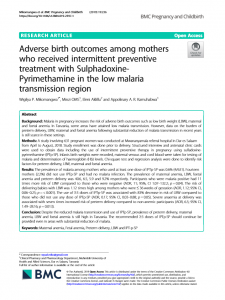
Background
Malaria in pregnancy increases the risk of adverse birth outcomes such as low birth weight (LBW), maternal and foetal anemia. In Tanzania, some areas have attained low malaria transmission. However, data on the burden of preterm delivery, LBW, maternal and foetal anemia following substantial reduction of malaria transmission in recent years is still scarce in these settings.
Methods
A study involving 631 pregnant women was conducted at Mwananyamala referral hospital in Dar es Salaam from April to August, 2018. Study enrollment was done prior to delivery. Structured interview and antenatal clinic cards were used to obtain data including the use of intermittent preventive therapy in pregnancy using sulfadoxine-pyrimethamine (IPTp-SP). Infants birth weights were recorded, maternal venous and cord blood were taken for testing of malaria and determination of haemoglobin (Hb) levels. Chi-square test and regression analysis were done to identify risk factors for preterm delivery, LBW, maternal and foetal anemia.
Results
The prevalence of malaria among mothers who used at least one dose of IPTp-SP was 0.6% (4/631). Fourteen mothers (2.2%) did not use IPTp-SP and had no malaria infection. The prevalence of maternal anemia, LBW, foetal anemia and preterm delivery was 40.6, 6.5, 5.9 and 9.2% respectively. Participants who were malaria positive had 11 times more risk of LBW compared to those who were negative (AOR, 11; 95%, CI 1.07–132.2; p = 0.04). The risk of delivering babies with LBW was 1.12 times high among mothers who were ≤ 36 weeks of gestation (AOR, 1.12; 95% CI, 0.06–0.25; p = < 0.001). The use of ≥3 doses of IPTp-SP was associated with 83% decrease in risk of LBW compared to those who did not use any dose of IPTp-SP (AOR, 0.17; 95% CI, 0.03–0.88; p = 0.05). Severe anaemia at delivery was associated with seven times increased risk of preterm delivery compared to non-anemic participants (AOR, 6.5; 95% CI, 1.49–28.16; p = 0.013).
Conclusion
Despite the reduced malaria transmission and use of IPTp-SP, prevalence of preterm delivery, maternal anemia, LBW and foetal anemia is still high in Tanzania. The recommended ≥3 doses of IPTp-SP should continue be provided even in areas with substantial reduction of malaria.